Ant Steel: St Albans street artist melding medieval with modern
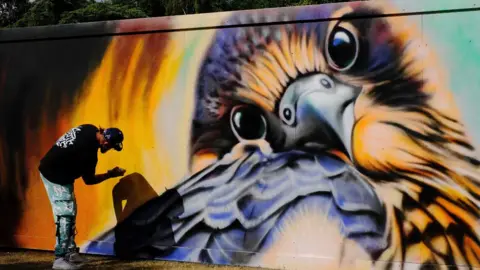 Phil Gelb
Phil GelbA cathedral has brought in a graffiti artist to be its latest artist-in-residence. How do you mix a modern genre with the work of a Norman church?
St Albans Cathedral in Hertfordshire is the oldest site of continuous Christian worship in Britain.
But for anyone who has concerns about bringing graffiti to a building which has stood for nearly 1,000 years, artist Ant Steel is quick to reassure us that he's "not actually painting on any of the walls".
"This is funny in a way because there are between 2,000 and 3,000 pieces of [medieval] graffiti in the cathedral," he said.
"There's always the question, what would happen if I was to do some graffiti now? Well, I'd be kicked out."
 Phil Gelb
Phil GelbInstead, he has been invited to bring his work, also known as street art, into the cathedral that is built on the site where Alban, Britain's first martyr, was buried.
He's aiming to collaborate with local people to produce works.
Norwich-born Ant has lived in St Albans for six years after about 20 years in South Africa, where he had an animation studio and produced TV commercials.
"I had this passion to get back to tactile painting and creating and also I wanted to do something that engaged more with the public," he said.
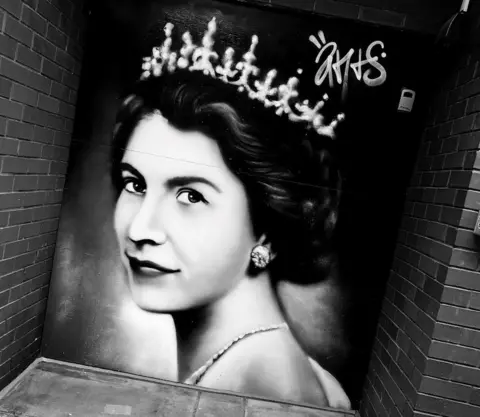 Phil Gelb
Phil GelbHis spray-painted work in the city, including a wall for Ukraine and an image of Queen Elizabeth II for the Platinum Jubilee, have built a following.
But he does not paint without permission.
"I'm not your stereotypical graffiti-underneath-the-train-tracks type of artist," he said.
"My path has been more commercial, so I'm really more about a message - about emotive pieces that connect with the community.
"I don't want to break any rules and I think it's really important to put forward street art as a legitimate art format that people can engage with and appreciate."
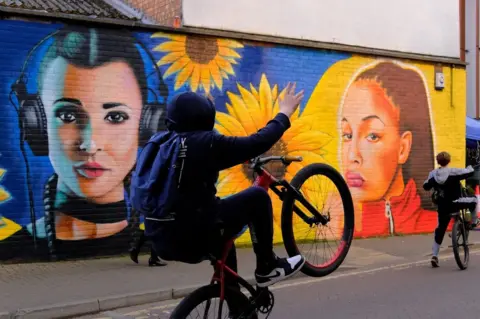 Phil Gelb
Phil GelbLast summer, he was approached by the St Albans Film Festival to lead a workshop for children in the Abbey orchard, and his image of cathedral peregrine chick Artemis did not go unnoticed by the church hierarchy.
He said he was "dumbfounded" when they asked him to join their ranks.
"I'm in awe of the building; it's phenomenal," he said.
His first job was to learn about its history for inspiration, but he said most of the work would be community-driven.
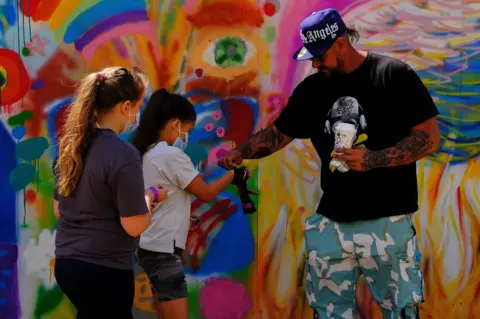 Phil Gelb
Phil GelbWorkshops with groups including children, asylum seekers, refugees and adult learners, will culminate in a November exhibition that will also include his own paintings.
"The idea for the workshops is to give information about street art and how I go about creating my art and then just get everybody to collaborate and have fun putting things together," he said.
"I try to teach people to respect each other's work and learn how to use the medium to tell a story or to start a debate - something that's meaningful to them."
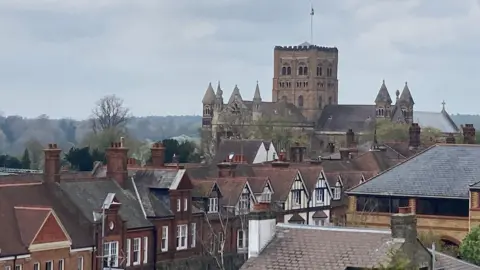 Katy Lewis/BBC
Katy Lewis/BBCAs the city's focal point, the cathedral is an ideal base to connect with all ages, he said, and just as a church is for the community, so is graffiti/street art.
"I see it as different from other forms of art because to me the artist who is painting a landscape is mainly doing that for themselves because that's what they want to paint," he said.
"Street art is something I want to do, but it's so important that it engages with the community and has an emotional connection.
"Also, to have the chance to get more children and teenagers to come in and appreciate what we have here will be tremendous.
"The worship side is obviously there, but it's also about community, connection and how everyone is welcome - total inclusion."
 Phil Gelbs
Phil GelbsA workshop to mark the start of his tenancy saw him paint an image of a black and white cherub, with participants drawing whatever they wanted around it.
"I wanted all the colour around it to come from the community," he said.
He also wants his work to reflect the graffiti that has been carved there by parishioners and visitors over hundreds of years, so that there is a link between the past and present.
Thousands of marks are etched into the columns and walls and he wants to use "some of the more recognisable" ones, to "echo back" what is already there.
"I'll also pick up on designs and patterns in there and make them more street art-ish," he said.
"But all the works that I do will be on boards."
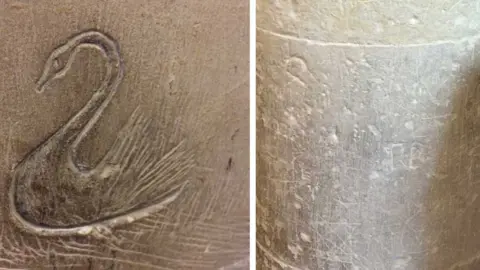 Katy Lewis/BBC
Katy Lewis/BBCHe also hopes to realise a dream to form a kind of "street crew" to take to other sites in the city and "liven-up areas".
"Children could actually feel a sense of ownership of their environment... this [tenancy] is an enabler of that for me, so I'm super excited," he said.
"If I can involve the community and get them together then that's my job done."
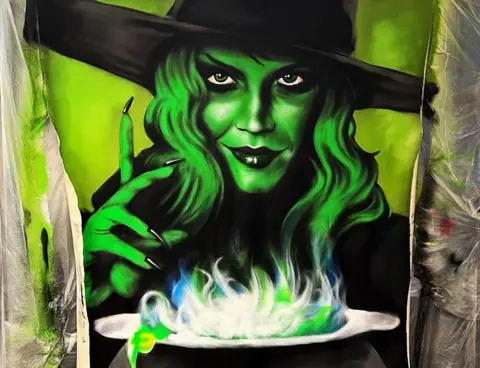 Phil Gelb
Phil GelbHe revealed he has a "loose structure" for the residency and the theme will be revealed later.
"I am aware that the works I create will become part of the history of the building which is why I have taken the task very seriously," he said.
"Each painting should tie into one another and, at the end of my residency, will reveal a master plan and one of my biggest recent inspirations.
"I hope to leave a legacy that is emotive, engaging and relevant."
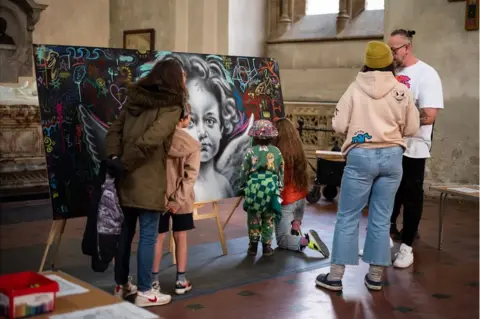 Phil Gelbs
Phil GelbsCathedral Dean, Jo Kelly-Moore, said: "In cathedrals throughout the ages artists of every genre have, through their creative gifts, invited pilgrims, visitors and worshippers to reflect on life in our world through the lens of the divine.
"Graffiti is one of those genres and the ancient stones of St Albans Cathedral and Abbey Church tell that story.
"We warmly invite everyone to come and join us in this exciting season to experience Ant's amazing work and, in his workshops, add your graffiti art to the story."
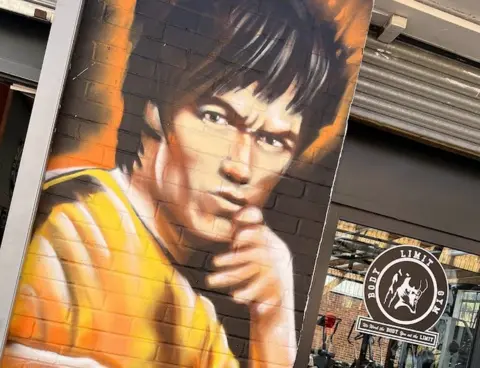 Phil Gelb
Phil Gelb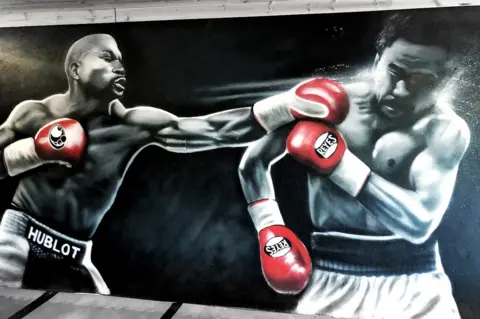 Phil Gelb
Phil Gelb
Find BBC News: East of England on Facebook, Instagram and Twitter. If you have a story suggestion email [email protected]
